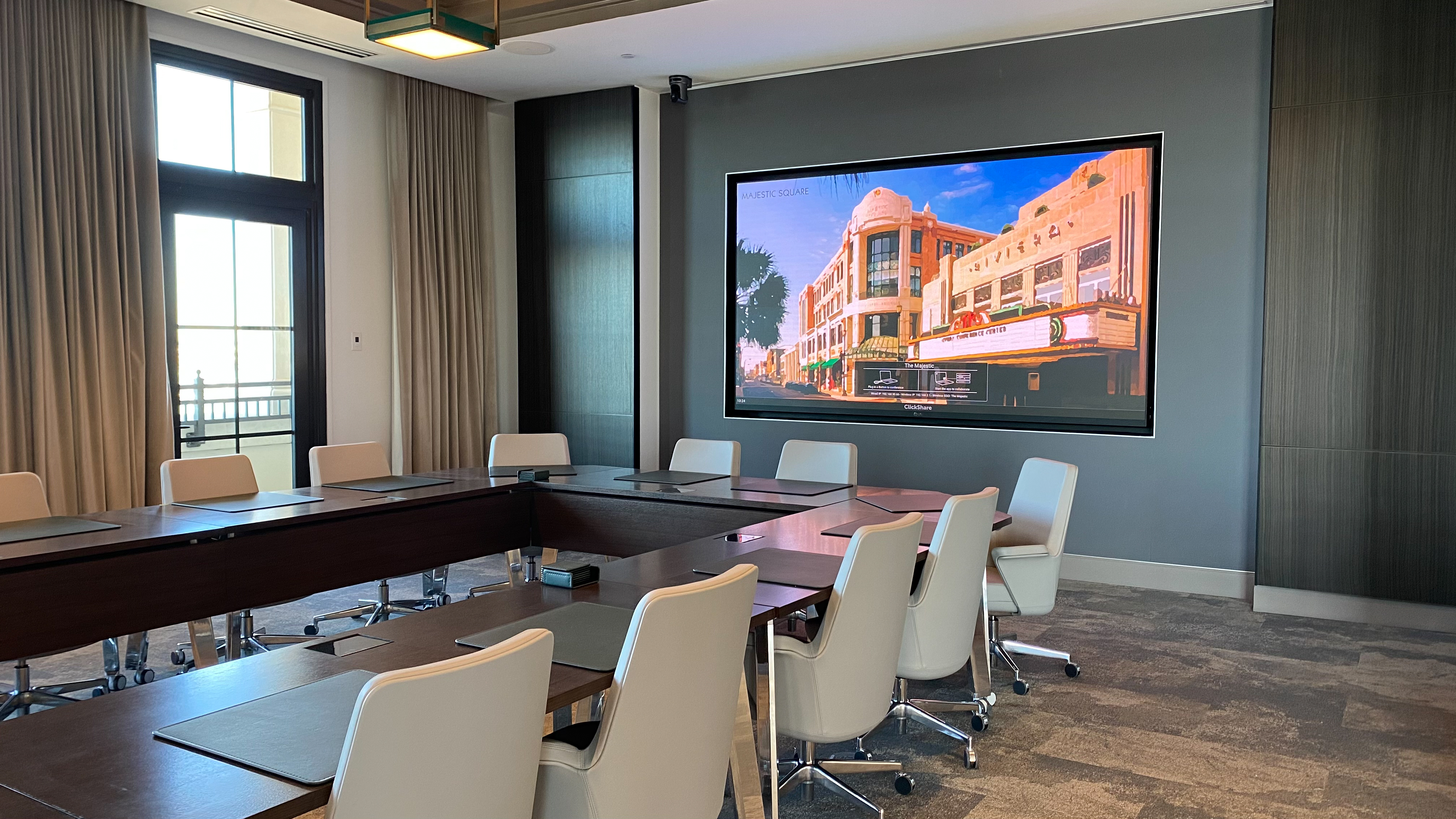Why dvLED Is Gaining Market Share
The display technology delivers a new look for installations—here’s what to expect from the display technology in the coming years.

The AV industry and meeting spaces—conference and boardrooms, classrooms, and amphitheaters—have been intertwined for decades. The need for visual support (and sometimes audio) goes back just as far. Our industry’s biggest trade association—AVIXA—started life in 1939 as the National Association of Visual Education Dealers (NAVED) to promote increased government funding of education when visual aid options were limited to film projectors, chalkboards, and flip charts.
Over time, projection displays became more sophisticated and brighter. Starting in the 1970s, electronic displays such as CRT televisions and monitors began supplanting film projection, but it wasn’t until the 1990s when projectors really took off, following the introduction of first liquid-crystal display (LCD) and then Digital Light Processing (DLP) video and data projectors.
It's a certainty that prices for indoor dvLED monitors and walls will drop substantially throughout the decade, and they will increasingly crowd out other display types.
Since then, advances in image resolution, brightness, and color accuracy have come at breathtaking speeds. Projectors got smaller, brighter, and cheaper. Experimental flat-screen imaging technologies (LCD and plasma) finally went mainstream with ever-larger sizes. Pixel counts soared from VGA (640x480) to XGA (1024x768) to Full HD (1920x1080) to Ultra HD (3840x2160). Aspect ratios went wider and video signal formats transitioned from analog (VGA, RCA, BNC) to digital (DVI, HDMI, DisplayPort)—and got smarter along the way.
Many industry analysts wondered where it would all end, if it even could end. Over the past decade, we’ve seen plasma fall by the wayside, high-brightness LCD monitors push projectors out of more and more once-secure applications, and flexible organic light-emitting diode (OLED) displays capture market share in smartphones, tablets, televisions, and even digital signage.
Beginning of the End?
The latest display tech threatens to replace every other display that preceded it. Direct-view inorganic LEDs (dvLEDs), once an expensive and exotic display platform largely relegated to digital signs and stadium scoreboards, are available with smaller pixel pitches in sizes that are practical for use in meeting and learning spaces.
[SCN Hybrid World: Look Up, Listen Up with These 9 Ceiling Mics]
These smaller pixel pitches (down to about .8mm, equivalent to that of a 60-inch plasma TV from 2010), coupled with bright, saturated colors and immersive-level contrast, have made dvLED walls a practical choice for indoor spaces. True, they are very expensive. But the first 50-inch WXGA plasma monitors had price tags exceeding $30,000 in 1997, and those 500-lumen (with a hotspot) VGA LCD projectors from 1994 cost just south of $10,000.
A daily selection of features, industry news, and analysis for AV/IT professionals. Sign up below.
It's a certainty that prices for indoor dvLED monitors and walls will drop substantially throughout the decade, and they will increasingly crowd out other display types. For one thing, dvLEDs have ample luminance to combat high ambient light levels. If anything, they can be too bright in darkened rooms, which necessitates operating them at a fraction of their specified luminance (which, of course, would extend their useful life).

Consider that a “bright” LCD display using conventional LED backlights can achieve levels of 300 to 400 nits, while one equipped with quantum dot (QD) technology will push the bar higher to 1,000 nits. That’s not even breathing hard for a 1.2mm-pitch RGB dvLED display, which leaves everything in the dust at 1,600-2,000 nits. That, in turn, begs the question: Can a display be too bright? (Yes, it can, but that’s a subject for a future article.)
Currently, dvLED manufacturing is dominated by China, which has a higher ratio of installed dvLED to flat-panel displays than other regions of the world, particularly in transport, hospitality, healthcare, and control room applications. Market research firm Omdia predicted last August that the average dot (pixel) pitch of indoor and outdoor dvLEDs shipped worldwide will fall to 2.1mm by 2026, and that 1.2mm LED video walls are becoming common in command-and-control rooms, with 0.8mm pixel pitch products also on the way. The Omdia report also stated that the share of LCD panels in Chinese projects will decline from 68.9% in 2019 to 30% by 2026.
Pros and Cons
As opposed to OLEDs mentioned earlier, iLEDs don’t suffer from problems with differential aging of colors (as did plasma and CRTs). Blue iLEDs last as long as green and red. And dvLED displays don’t operate in a continuous mode—the power consumption and heat generation would be considerable.
[Rust Never Sleeps ... and Neither Do Display Manufacturers]
Instead, dvLED displays use a switched operating mode with pulse-width modulation (PWM) to transition from an “off” state to an “on” state thousands of times per second. The ratio of “offs” to “ons” in a given time interval generates a specific luminance value for each color. And the cycle (refresh) rate is so fast that there’s no chance you’ll see any flicker.
The high luminance levels of dvLED displays make them a great solution for any meeting space, particularly flex spaces with high ambient light levels. A typical classroom or meeting room using fluorescent or LED lighting could have a typical ambient light level of 100 lux. To achieve the desired 15:1 contrast ratio recommendation for this space, we’d need roughly 6,000 lumens from a projector on a 120-inch diagonal screen. That would translate into a direct-view display rated at 460 nits, which is pushing a conventional LCD monitor or wall hard, but barely taxes a dvLED.
Regarding color, dvLEDs can produce colors with high levels of luminance and saturation that exceed the older ITU Rec.709 color gamut, more closely match the digital cinema DCI P3 minimum color gamut, and cover a good deal of the newer ITU Rec.2020 gamut. Unlike phosphor-generated or organic material colors that have limitations on peak luminance, dvLEDs can push out very intense red, green, and blue shades and reproduce high dynamic range (HDR) visual content. Only quantum dot-equipped LCDs can approach that level of performance, but they can’t match up against dvLED’s high contrast and color saturation over wide viewing angles.
To be sure, dvLEDs require good heat management. They get pretty warm even when using switched PWM techniques. While LED device lifetimes have improved considerably over time, they still can and do fail, requiring replacement of individual tiles. Perhaps it’s no surprise that dvLED power supplies can also be a major point of failure (as they are in so many other electronic devices). With all that illumination horsepower at the touch of a button, it takes careful design of the viewing environment to make sure you don’t cause eyestrain by using only as much screen luminance as you need.
[Digital Signage Wins Big at Route 66 Casino]
Small-pitch dvLED walls are already making their way into everything from real estate offices to houses of worship and major medical centers. And they don’t have to be permanently installed: Several prototypes of roll-around widescreen dvLED displays have been shown at InfoComm. These “go anywhere” displays are easily assembled by two people using locking tiles and connectors, and the only interfaces are an HDMI connector and AC power.
The modular nature of dvLEDs also makes it a lot easier to achieve large screen sizes during installation—moving 80-inch and larger one-piece displays can be a difficult task in some spaces. Achieving even larger sizes like 100 and 120 inches is also a much simpler task, particularly since one-piece LCD and OLED displays aren’t currently available in those sizes.
Pete Putman, CTS, KT2B, is the president of ROAM Consulting.

